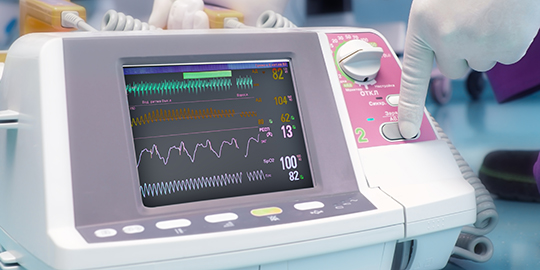
Medical Devices Industry: 'Collaboration between MNCs & domestic players key for growth'
Interview by Sai Nikesh | The Dollar Business
The Dollar Business (TDB): Are there any notable improvements in the Indian medical devices industry post the issuing of ‘National Medical Devices Policy-2015’ by the Department of Pharmaceuticals? Pavan Garikapati (PG): Draft NMDP 2015 was released by Department of Pharmaceuticals on June 3, 2015. Three major points of the policy are Promotion of Industry, Promotion of Quality and Promotion of Skills. It is highly commendable to focus on these aspects. This policy has great potential to boost the quality, reliability and competitiveness of the Indian Medical Device industry. However, the details need to be chalked out to implement this policy. The regulations should be aligned to the policy. The policies can be prioritized for a specific category, for e.g. India needs quick and efficient diagnostic devices in addition to preventive or curative devices, at this hour. TDB: To what extent will NMDP 2015 help the Indian medical devices industry in going forward in line with ‘Make in India’ and in order to compete at the global level?
 Pavan Garikapati, Regulatory Domain Head, Medical Devices, Wipro Ltd.
Pavan Garikapati, Regulatory Domain Head, Medical Devices, Wipro Ltd.PG: The Draft National Medical Device Policy-2015 has given the much needed impetus to the medical device manufacturers. The three-fold strategy that seeks to promote industry, quality and skills will have a significant impact. Pricing Control helps in spurring competition between MNCs and local companies. These measures will hopefully encourage MNCs to set up shop in India and reap the same benefits as the local players. The development of an ecosystem will improve quality and enable medical devices that are made in India to become more competitive in the global market. The creation of a large skilled workforce will generate several new opportunities. The policy will have a domino impact on the related industries such as testing labs, raw material providers, manufacturing equipment suppliers and service providers (IT) among others. Overall, a healthy move not only from the perspective of the industry and nation, but most importantly in extending the reach of affordable healthcare. TDB: With over 800 equipment manufacturers, the Indian medical device industry remains under medium and small-scale enterprise category with majority of requirements being met by imports. So, what do you think are the major challenges affecting growth of domestic industry and basic challenges that are being faced by the Indian medical device manufacturers? From the industry side, do you have any key suggestions for DoP? PG: The Indian Medical Device industry works on a low price, high volume model. Local players majorly face the challenges of scalability, credibility and brand value. Since the regulatory framework is developing, now hospitals/users depend on whether the device is approved in tier 1 countries/regions (viz: US, EU, Japan, Canada, and Australia), for e.g CE Mark. To ensure that MNCs and local players have a level playing ground in the Indian market, regulations and market approval processes should be strong. Adopting the major regulations to level the competition could be another strategy, for e.g. Canada has adopted ISO 13485 for Medical Device QMS (Quality Management System). DoP should focus on strengthening regulatory framework, assisting with policies that enable investment and creating the product approval system. TDB: Issues like lack of local manufacturing policy, subsidies, incentives, proper education promoting R&D activities, amongst others, were also cited as reasons that are hindering the growth of domestic medical device industry, by the DoP in NMDP-2015 draft issued on June 3, 2015. What is your take on this? PG: The growth of medical devices industry is based on the issues mentioned. These issues are described in the policy, however successful implementation requires detailed drafting of these policies and careful implementation. One of the major growth hindrances is credibility. This needs strengthening of regulatory framework and unifying the regulations across states. TDB: Despite being one of the top twenty markets in the world and fourth-largest in Asia after Japan, China and South Korea, the share of medical devices in the ‘Made in India’ basket remains relatively small. What do you think is ‘need of the hour’ to kick start the growth process and keep up the domestic industry in competition with global markets? PG: There is a need to fulfill the demand with low priced quality devices from local players. This should be initiated by MNCs, setting up their manufacturing facilities, following the automobile manufacturing trend. This sets a quality standard, spurs competition and ensures high quality at low price- a collaborative approach for mutual benefit. TDB: Imports cater to over 65% of the demand for medical devices in India, of which four-fifths are accounted for by medical electronics, surgical and hospital equipment, implants and diagnostic re-agents and the medical electronics sector is expected to reach the $2 billion mark in 2015, after having grown at a CAGR of 17% during the last five years. Do you think the domestic industry will need technical collaborations with MNCs that have been filling requirements in case of high-end medical equipment? PG: There are very few local corporate players investing in medical devices. A collaboration with MNCs can bring in huge investment support, initial R&D and manufacturing acumen. This will create a win-win situation for both MNCs and local players. However startups also make an important contribution in this area, which requires fully developed venture capital support system.
June 13, 2015 | 5:35 pm IST.






 to success.
to success.